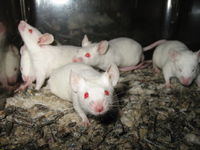Mice (Laboratory) - Pathology
| This article has been peer reviewed but is awaiting expert review. If you would like to help with this, please see more information about expert reviewing. |
Anatomic features
The laboratory mouse has several unique characteristics, and there are vast differences in normal anatomy, physiology, and behaviour among different strains of mice, many of which represent abnormalities arising from homozygosity of recessive or mutant traits in inbred mice.
The dental formula is 2(I 1/1, M 3/3) = 16. The incisors are open-rooted and grow continuously.
The stomach is divided into a proximal nonglandular portion and a distal glandular portion.
The left lung consists of one lobe, while the right lung consists of four lobes.
Mice have 3 pectoral and 2 inguinal pairs of mammary glands, with mammary tissue enveloping much of the subcutis, including the neck. Mammary tissue can be found immediately adjacent to to salivary glands.
The mouse has the narrowest thermoneutral zone of any mammal thus far measured. A mouse responds to decreases in ambient temperature by nonshivering thermogenesis, and to increases in ambient temperature by decreasing metabolic rate and increasing vascularization of the ears. Nonshivering thermogenesis can produce a threefold increase in basal metabolic rate, and for the most part occurs in brown fat. The highest concentration of brown fat is found in the subcutaneous tissues between the scapulae.
The brain and spinal cord are larger in mature male mice compared to females.
The zona reticularis of the adrenal cortex is not discernible from the zona fasciculata. A unique feature of the mouse adrenal is the X zone of the cortex, which surrounds the medulla. The X zone is composed of basophilic cells but when males reach sexual maturity and females undergo their first pregnancy, the X zone disappears.
Melanosis occurs in several organs, including the anteroventral meninges of the olfactory bulbs, optic nerves, parathyroid glands, heart valves, and spleens of melanotic mouse strains, such as B6 mice.
Strain Information
Most laboratory mice have contributions from both Mus musculus musculus and Mus musculus domesticus. There is evidence that smaller contributions also may have come from Mus musculus molossinus and Mus musculus castaneus. Therefore, they should not be referred to by species name, but rather as laboratory mice or by use of a specific strain or stock name. (In addition, some recently developed laboratory mouse strains are derived wholly from other Mus species or other subspecies, such as M. spretus). The laboratory mouse genome, including its retroelements, is a mosaic and an artificial creation, and there is no true "wildtype" laboratory mouse. There are over 450 inbred strains that have arisen during the last century but the great majority of biomedical resaerch, including genomic research, is based on a relatively few mouse strains, including C57BL/6, BALB/c, C3H/He, 129, FVB, and outbred Swiss stocks.
For more information on specific strains and the pathology associated with them, click here
Genetically Engineered Mice
Terminology
Genetically engineered mice have induced mutations, including transgenes, targeted mutations (knockouts or knockins), and retroviral, proviral, or chemically-induced mutations.
Transgenic mice carry a segment of foreign DNA incorporated into their genome via non-homologous recombination (e.g., pronuclear microinjection), infection with a retroviral vector, or homologous insertion.
Targeted mutant mice are produced by first inducing gene disruptions, replacements, or duplications into embryonic stem (ES) cells via homologous recombination between the exogenous (targeting) DNA and the endogenous (target) gene. The genetically-modified ES cells are then microinjected into host embryos at the eight-cell blastocyst stage. These embryos are transferred to pseudopregnant host females, which then bear chimeric progeny. The chimeric progeny carrying the targeted mutation in their germ line are then bred to establish a line. If the newly established line has a disrupted or deleted gene, it is called a knockout; if it has a new or duplicated gene, it is called a knockin.
Mice with chemically-induced mutations are produced by using a variety of chemicals. One popular chemical mutagen, ethylnitrosourea (ENU), is used to induce point mutations. ENU mutagenesis involves exposing male mice to ENU and then mating the treated males to untreated females. The resultant progeny, many of which carry point mutations, are screened for phenotypes of interest.
Applications
Genetically engineered mice are useful for elucidating basic biological processes, studying relationships between gene mutations and disease phenotypes, and modeling human disease. Research applications are included on strain data sheets in the JAX® Mice Database. The applications are compiled using a number of information sources (please refer to Mouse Information Resources), but they are not all-inclusive: rapidly advancing biomedical research continually uncovers new applications and uses for genetically engineered and mutant mice strains.
Some genetically engineered and mutant mice strains have a mutation associated with a specific human disease. If the gene or mutation is orthologous to that in humans and causes the same disease in humans, the strain is designated as a model of the human disease. Manifestation of the genetic mutation (phenotypic expression) may differ between humans and mice. Investigators are strongly encouraged to research recommended mouse models to be sure they are appropriate for their research.
References
- Percy, D.H., and Barthold, S.W. (2007) Pathology of laboratory rodents and rabbits. Blackwell Publishing. pp. 3-123.
